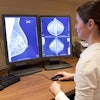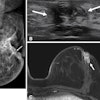
When patients go to subspecialists for second-opinion interpretations of suspicious breast imaging exams, the original interpretations change approximately half the time, according to a study published online June 28 in the Journal of the American College of Radiology.
The researchers found that subspecialist second-opinion reviews of breast imaging in patients without a cancer diagnosis led to changes for 51% of the women. The reviews also identified 35% more cancers and helped avoid 25% of recommended biopsies that would have been benign.
The results are encouraging for women with suspicious mammographic findings who would like more clarity on how to proceed, wrote the team led by Dr. Kristen Coffey from Memorial Sloan Kettering Cancer Center.
"[Women] with a new mammographic or sonographic finding will often seek a second opinion from a breast imaging specialist at another institution," the group wrote. "[Studies] have demonstrated that specialists outperform general radiologists in detecting additional cancers on screening and diagnostic mammography while also having lower recall rates, thus improving patient satisfaction and effectiveness of care."
For this study, Coffey and colleagues reviewed 415 mammograms submitted to Memorial Sloan Kettering for second-opinion review by 245 patients in 2014. Of the 245 patients, 147 with 176 lesions were selected (98 cases without follow-up or change in original BI-RADS 0 categorization were excluded).
The researchers compared original and second-opinion interpretations of breast imaging with histopathology results and follow-up imaging. Imaging included mammography (55%), ultrasound (41%), and MRI (4%) exams, and most of the exams were originally interpreted in a community setting.
Of the 176 lesions, 55% (96) were deemed suspicious on original breast imaging. The second-opinion review did not match the original interpretation for 47% of the lesions (82 of 176) and 51% of patients (75 of 147).
Second-opinion interpretation downgraded 25% of lesions (24 of 96) originally reported as suspicious to benign or probably benign, helping these women avoid unnecessary biopsies. It upgraded 39% of lesions originally classified as benign or probably benign to suspicious.
Of the total lesions included in the study, 87 were biopsied, with 28 (32%) not originally recommended for biopsy. Twenty-three of the 87 biopsied lesions were malignant (26%); eight of these 23 (35%) were cancers that had not been identified in the original mammogram interpretation.
"Overall, 51% of patients who sought a second opinion by a breast imaging specialist at our cancer center received a significant interpretation change," Coffey and colleagues wrote. "Because over three-quarters of the submitted studies were initially interpreted by radiologists practicing in the community, our observed discordance and increased cancer detection rates likely reflect differences in subspecialty training and experience among the radiologists."
What's the bottom line? Second-opinion review is beneficial to women, even before they've been diagnosed with breast cancer, the authors concluded.
"Our data suggest that second-opinion review is valuable for all patients regardless of breast cancer status," they wrote.




















